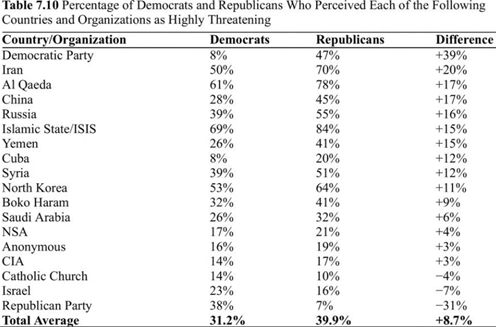Politics
Can Wall Art Predict Your Politics?
Research finds surprising differences between the left and right.
Posted July 11, 2024 Reviewed by Michelle Quirk
Key points
- Political ideologies have consistent attributes seen throughout democratic countries.
- Liberals and conservatives differ in personality and emotions such as fear and disgust.
- Being left or right is influenced by one's relative need for certainty and predictability.
If we know a person’s general emotional posture, I believe we can predict what ideologies he would choose if he were exposed to them—and whether they will be toward the left pole or the right. –Silvan Tomkins, 1965

What clues does your bedroom offer about your political leanings? Read the descriptions of each of these rooms and decide which more closely aligns to yours:
Bedroom 1: Walls lined with flags and sports décor, an event calendar hanging neatly near a set of postage stamps, an iron and ironing board, laundry basket, and a couple of alcoholic beverages on a nightstand.
Bedroom 2: Shelves full of books on a wide variety of topics, walls donned with maps of foreign countries, a large selection of music including oldies and folk, and a desk covered in stationery and art supplies.
Researchers would predict that if you chose the first, you are probably politically conservative. If you selected the second bedroom, you are more likely liberal.
Political psychology has made major strides in recent decades, as interesting patterns have been revealed between participants who classify themselves as left versus right. Those on the political right tend to prefer conservative policies and candidates who uphold tradition or strive to revert to a simpler past. Those on the left tend to support progressive policies that advocate for change, especially those aimed at reducing inequality. (Much of these findings on the left-versus-right paradigm withstand cross-cultural comparisons.)
Given these admittedly oversimplified descriptions of left and right, how would you classify yourself? John T. Jost, co-director of the Center for Social and Political Behavior at New York University, argues that those on the left differ from the right in personality, emotions, and psychological needs. See how well your answers to the following questions align with the research.
Personality
Do you agree or disagree with the following statement: What our country really needs is a strong, determined leader who will crush evil and take us back to our true path.
If you agree, you align with the right-wing. If you disagree, you align with the left. This question came from the Right-wing Authoritarianism (RWA) Scale developed by Bob Altemeyer. Rightists are more likely to submit to authorities perceived as legitimate. Authoritarian attitudes are especially prevalent during highly threatening situations. Researchers in the United States found that the greater a participant’s endorsement of authoritarianism, the more likely they were to support Donald Trump or Ted Cruz over Hilary Clinton or Bernie Sanders.
Which statement do you agree with more:
- Human nature is basically good.
- Human beings are basically evil.
If you selected statement 1, you align with most leftists. If you selected 2, you align with rightists. This question comes from Artur Nilsson’s Humanistic and Normativistic subscale. People attracted to the left generally embrace humanistic values and believe people are good. They think that the purpose of society is to facilitate personal growth, whereas rightists are focused on normative concerns such as minimizing irresponsible behavior using rules and setting limits.
Which would you prefer to look at:
- A painting that is complex and abstract.
- A painting that is simple and representational.
If you answered option 1, then you align with the left-wing answer. Option 2 aligns with the right. Artwork preferences were offered as evidence of a broader finding that liberals and conservatives differ in their tolerance for uncertainty. Leftists preferred complex poems and music. They tended to score higher on levels of openness to experience when given the Big 5 Personality Test. Rightists were more likely to prefer traditional poems and familiar music while avoiding ambiguity and novelty. They also typically have tidier bedrooms (as mentioned earlier) and score higher on levels of conscientiousness.
Emotions
On a scale from 1 to 4, where 1 is "Not disgusting at all" and 4 is "Very disgusting," rate the following scenario: “You see maggots on a piece of meat in an outdoor garbage pail.”
This question was used as part of the Disgust Sensitivity Scale. Researchers found that higher levels of disgust predicted self-reported conservatism. Disgust sensitivity also predicted responses to political issues relating to gay marriage, abortion, unions, and tax cuts. The causal relation here is unknown. As the authors state, "Other factors, such as geographical location, doubtless exert a strong influence on political attitudes—a resident of Utah is far more likely to be conservative than a resident of Massachusetts, but it seems unlikely that Utah residents are dramatically more disgust-sensitive than Massachusetts residents. Our data show that disgust and politics are linked most strongly for issues of purity, such as attitudes towards homosexuality (see also Inbar, Pizarro, Knobe, & Bloom). But the nature of this link, and how sexual attitudes connect to political attitudes more generally, is a topic for further research."
Conservatism is associated with gray matter volume in the left insula, a brain structure associated with disgust. Recent research has found that genetically heritable taste sensitivity and taste-bud density are associated with disgust and political conservatism. Differences in taste sensitivity may actually serve as a biological predisposition that leads an individual to adopt one ideology over another.
Which statement would you find more persuasive:
- Voting is a way to express and live in accordance with important values.
- Not voting allows others to take away your right to express your values.
If you found statement 1 to be more persuasive, you align with leftists. If statement 2, you align with most rightists. In this study, researchers framed arguments that were either reward-focused or threatening. These effects carried over into behavioral intentions and actual voting behaviors in the 1996 presidential election.
In addition, conservatives are more sensitive to threats than liberals. Right-wing conservatism is positively correlated with right amygdala volume, a brain structure associated with emotional processing, especially fearful and threatening stimuli. When participants were presented a list of potential threats to the United States, Republicans were more likely than Democrats to regard 35 out of 46 of them to be highly threatening. (See a portion from the table below.)

Psychological Needs
Do you agree or disagree with the following statement: A group that tolerates too much difference of opinion among its own members cannot exist for long.
If you agree, you align more with the right-wing answer. If you disagree, then you're more likely on the left. This question comes from the Dogmatism Scale. Researchers have found that politically conservative individuals tend to have more dogmatic thinking—that is, thinking that is black-and-white, rigid, and simplistic. Rightists have a higher need for predictability, closure, and structure. Liberals have a higher tolerance for uncertainty, ambiguity, and complexity and a greater need for cognition.
How well did your answers match up with what the research would predict? It’s possible the questions failed to predict your politics, especially if you classify yourself as a moderate with a mixture of views. The evidence presented here is based on averages across large samples of unique individuals. While left and right ideologies help us predict psychological differences, they overlap considerably.
Differences in personality, emotion, and psychological needs between the left and the right continue to add to our understanding. While Jost has found that our political worldviews help us meet psychological needs such as a sense of safety and control, he also notes that it’s important to allow scientific evidence to shape our views.




